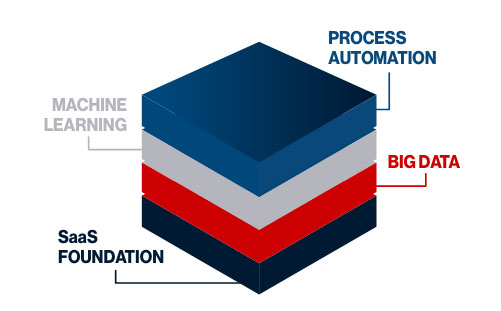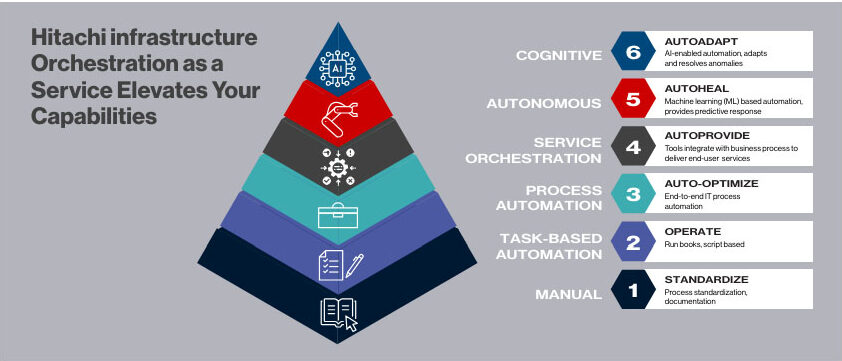As an IT infrastructure and operations leader, you may find that the path to success for your digital transformation can be quite challenging. There are far too many variables that require basic decisions before you can even begin. You need to decide how much should move to public cloud. You need a decision on how much hybrid or private should be adopted. You’ll need to decide on the automation strategy: Do you take a one-platform approach that unites and orchestrates stovepipes of management and automation? Or, will you choose an endless technology toolbox that attempts to apply individual best-in-industry solutions to automate every end-to-end process? You’ll also want to determine how you will incorporate artificial intelligence (AI) into the IT modernization strategy.
These questions must be answered before a timely and efficient digital transformation can even begin. Otherwise, you risk that these new technologies and approaches for fully autonomous operations might be nothing more than a science experiment. What you really want is proven capability with predictable outcomes. Luckily, there is a way to successfully navigate through all this complexity and confusion. Hyperautomation has emerged as the approach that will do just that.
In simple terms, hyperautomation is a systematic approach to orchestrate multiple technologies, driving end-to-end process automation for complex workflows. That means it’s automating many multivendor systems and how they interact with each other. Hyperautomation utilizes more advanced technologies like AI, intelligent business process management (iBPM), and robotic process automation (RPA), connected to a fully integrated environment.
Traditional automation has worked well in the past when the actions and steps of the task were predictable, like provisioning more capacity to avoid having a database crash. Hyperautomation is designed to also automate the thinking and decision-making part of a complex process, like deciding whether older data should be archived out to make more space available.
Disconnected workflows
With many companies still working around fragmented environments, automation is an imperative and will continue to grow for the foreseeable future. Without automation, manual intervention is required, which limits agility and slows market competitiveness.
Data silos
Part of the fragmentation of the environment is due to still-existing silos within the organization that may be managed and automated differently based on their purposes. To move a project forward, IT often must manually intervene. If errors or delays occur, reaction time is slowed, again due to manual response needed to address each silo involved in the process.
IT complexity
The expansion of IT complexity has created more challenges than ever before, causing technologists to struggle to manage and make sense of overwhelming data noise. We have seen this to be especially true for our clients struggling to manage their heterogenous environments. They are experiencing poor visibility into the environments that power their business processes and obfuscate risk in conducting compliance management.
Compliance
Risk management has not kept pace with the proliferation of digital transformations. A gap is opening that can only be closed by risk innovation at scale.
Poor insights
Without clear insights and a modern approach to data and analytics governance, organizations seeking to scale digital business run a higher risk of failure.
A well-designed hyperautomation solution will scale automation in your enterprise. It will help optimize business performance and IT operations, and streamline processes, while accessing everything you need from a single pane of glass.

So, what’s the catch? First, hyperautomation can be complex. Skill and experience can make a big difference in designing and implementing the many different technologies, systems, and interactions for the countless number of processes. However, it is so new that it can be difficult to find staff, expertise or traditional technology providers that have designed and deployed these solutions once — let alone achieved a level of mastery in this area. Second, optimizing ongoing operations can be demanding without the right tools and experience in applying them in the face of constant change in requirements and IT deployments. Hyperautomation needs to be as dynamic and agile as your IT environment is.
Hitachi Digital Services has addressed these concerns with Hitachi infrastructure Orchestration as a Service. This software-asa-service (SaaS) offering assembles proven technologies and capabilities in modules to make it easier to get started. And it delivers hyperautomation through our experts as a service.

Hitachi infrastructure Orchestration as a Service optimizes business performance and IT operations. The solution provides continuous insights, intelligence and automation across the IT enterprise. And when combined with Hitachi Automation Suite solutions your hyperautomation solution will enhance your traditional IT service management (ITSM) and IT operations management (ITOM). Together, they apply advanced hyperautomation toolchains, such ML and AI, iBPM software, integration with platform as a service (iPaaS), and IT process automation, to create service-based infrastructure delivery and autonomous operations.
We streamline and automate to drive efficiency and governance standards throughout your operations. With Hitachi powering your move toward hyperautomation, you will transform your IT operations practices and rev up your competitive advantage.
Click here to learn more about how Hitachi infrastructure Orchestration as a Service and other managed services from Hitachi Digital Services will accelerate your business, reduce your operational costs, and speed your IT transformation.
By subscribing to Hitachi Digital Services’ Insights and providing your e-mail, you agree and consent to Hitachi Digital Services´ Privacy Policy and Website Terms of Use. Data Controller: Hitachi Digital Services Corporation. Purpose: manage Hitachi Digital Services.
Read More +
